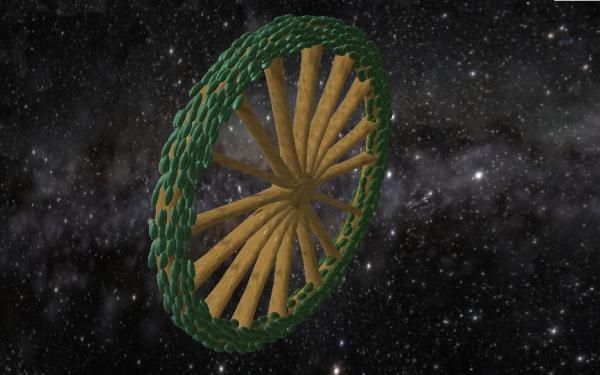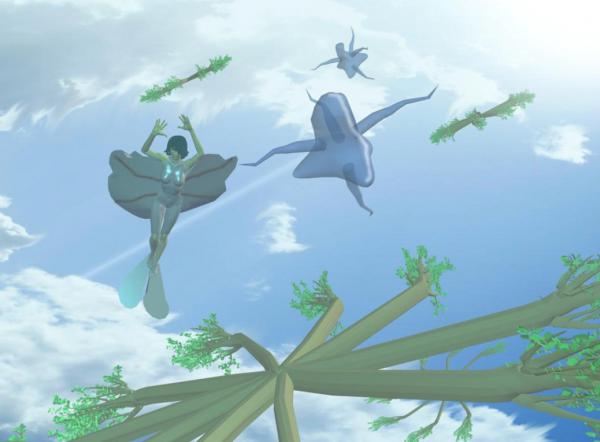BY LETTER
Dyson Tree Variant: Wagon Wheel
Technology > Technology Type or Material > Gengineering
Technology > Technology Levels > High Tech / Hitech
Technology > Application > Infrastructure
Technology > Application > Megascale Engineering
Technology > Technology Type or Material > Organic/Biotech
Technology > Technology Levels > High Tech / Hitech
Technology > Application > Infrastructure
Technology > Application > Megascale Engineering
Technology > Technology Type or Material > Organic/Biotech
Genetically modified tree grown in space which rotates to produce artificial gravity |
 Image from Steve Bowers |
WAGON WHEEL TREES
While traditional Dyson Trees (Orwoods) grow uniformly around a comet or asteroid to form enormous, roughly spherical zero-G forests, not every entity interested in inhabiting "giant space trees" is also interested in zero-G. The "Wagon Wheel Tree" is one answer: a Dyson Tree engineered in the image of a Stanford Torus.The Wagon Wheel Tree is a relatively simple modification of Dyson Tree genomes, at least compared to the epic modifications needed to turn a terrestrial plant into a space-adapted organism able to turn billions, even trillions of tons of asteroidal material into a tree within a century. The primary change is to genetically or horticulturally shape a Dyson Tree into a wheel, with the "rim" torus support by multiple spokes (ranging from 3 to dozens, depending on the whims of the designers and limits of the tree material). Some Wagon Wheel trees include genetically (or bionano) crafted chemical rockets to accelerate the tree to the desired spin, while others simply graft equipment like conversion torches (also obviously useful for any Dyson Tree) to the tree.
The scale of the resulting tree is dependent on the materials and technology the designers are willing to utilize, decisions often guided by aesthetics.
Those interested in relatively "natural" trees with a primarily cellulose-based structure are working with a material of approximately 30,000psi (207MPa) yield strength at best. And achieving that best requires modification of tree genomes to ensure ideal alignment of wood grain, minimizing knots and other flaws.
While such strength levels are quite low compared to conventional habitat materials, unlike more traditional space habitats Dyson Trees rarely have large pressurized volumes. Tunnels and chambers are usually meters to tens of meters in diameter instead of kilometers, but with walls that are meters thick (or much more). This means that atmospheric pressure is not the largest load on the tree. (For example, a 100-meter diameter cylindrical passage with a 1-meter wall thickness only sees about 11MPa hoop stress from a 1-bar internal pressure.)
Instead, weight is the largest burden. A rotating spoke of cellulose reaches its 207MPa limit at about 30,000 meters radius with 1G at the tip. A tapered spoke can be significantly longer depending on the taper ratio, while adding a rim (a continuous ring outlining a circumference around the spokes) demands a shortening of the spokes to carry the rim's deadweight. Because of the variability of organically grown cellulose structures and the loads of a rim, a practical 1G "Wagon Wheel" tree is typically limited to 5,000 meters radius or less.
A 5000-meter radius also assumes that pressurized volumes remain small, and that the core asteroid or comet is reduced to a small, low-pressure hub. "Small" pressurized volumes, in this case, are those that keep their stress levels below 10% of that imposed by the structure's weight, a limit partly imposed by the anisotropic strength distribution of fibrous structures. With a 1-meter wall thickness, cellulose material, and 1-bar of internal pressure, that limits a cylinder to about 180 meters radius, or 360 meters radius for a spherical chamber. Reductions in pressure linearly increase maximum radii. Assuming the designers stick to fire-safe atmosphere (not entirely oxygen), a further doubling in radius is possible while keeping the environment relatively neb-friendly.
The results, though, are still quite sizable habitats compared to modosophont standards.
Beyond material strength, there are other issues facing Wagon Wheel Trees absent in regular Dyson Trees. Planet-bound trees from Terra have difficulty lifting water from their roots to crowns when over 100 meters tall. Wagon Wheel Trees, typically keeping huge reservoirs of water and nutrients at their zero-G hub (the remains of their seed comet or asteroid), can easily run into a problem where they are unable to properly recirculate and recycle water and nutrients released from the hub down the kilometers-long spokes. Accordingly, active pumping is required by any of numerous means (symbiotic bionano, large symbiotes, peristaltic tubules, mechanical pumps, etc.) Either that or they use wasteful transpiration, releasing waste water and gases into space.
The hub deserves some mention, since the typical Wagon Wheel Tree seed body is fractured, fragile rubble pile of ice, carbonaceous material, and other materials. When spin is applied, even the low centripetal forces at the hub may apply unacceptable loads on the seed body. Naturally, the seed bodies are well-laced with roots to hold them together. Since they are also typically warmed by the growing tree, they are often encased in small chambers of water, separated nutrients, and minerals awaiting processing.
ALTERNATE MATERIALS
Terragen bioengineering is able to produce materials far stronger than cellulose, though, lacing plant structures with polymers and even nanotubes that dramatically increase tensile strength. Within the limits of Terran-derived genetic engineering, it is not unreasonable to increase tensile strengths of self-growing, self-sustaining plants to five times that of cellulose (allowing for the irregularity of organically grown engineered trees). The possible diameters of Wagon Wheel Trees grow linearly with strength (assuming pressurized volumes remain small).Reductions in rim gravity allow Wagon Wheel trees to be significantly larger, linearly so, than their 1G counterparts. For example, a 0.5G Wagon Wheel tree can have twice the diameter of a 1G tree of the same material.
For groups less interested in the authenticity of organically-grown cellulose structures (plain or reinforced), bionano, nano, and simply inorganic solutions exist for producing "self-growing solar-powered asteroid-mining fractal structures" that some consider to be Wagon Wheel Trees. Cut loose of the burden of tree-derived structures, structural strengths in terms of gigapascals are quite possible. Accordingly, dimensions in excess of 5,000 kilometers diameter are achievable for carbon nanotube Wagon Wheel Trees that exhibit 1G in their rims - without tapering or pushing the materials technology very far.
The slow-rotating "Sacred Heart" in the Biopolity makes liberal use of carbon nanotubes and has a 0.1G acceleration at its rim, allowing it to reach 50,000km in radius. It is a tree no less than 100,000 kilometers in diameter, larger than most of the planets of the Solar system and nearly as large in Saturn - though much, much less massive, of course. The rim is an intertwined bramble of relatively narrow 200-meter diameter corridors with a total of almost 400,000 square kilometers of habitat surface area, plus the countless chambers rising through the dozens of branching, tapering spoke-trunks.
VARIANTS
Asterisk Trees
 Image from Steve Bowers | |
| Some asterisk trees inside a circumstellar Smoke Ring slowly rotating in the steady orbital winds. | |
Space-based Asterisk Trees are known, variants of conventional Dyson Trees that eliminate the rims of Wagon Wheel Trees to reduce the stress imposed by the rim. Without tapering, Asterisk Trees can be about twice as wide in diameter as Wagon Wheel Trees.
Crown of Thorns
Opposite the Asterisk Tree is the Crown of Thorns, a type of Wagon Wheel Tree often named quite differently in the Sophic League. Instead of eliminating the rim in favor of the spokes, the Crown of Thorns eliminates the spokes in favor of a more massive rim that, as the name implies, sprouts countless minor branches for photosynthesis and heat elimination.Related Articles
Appears in Topics
Development Notes
Text by Mike Miller
Initially published on 16 July 2013.
Initially published on 16 July 2013.






